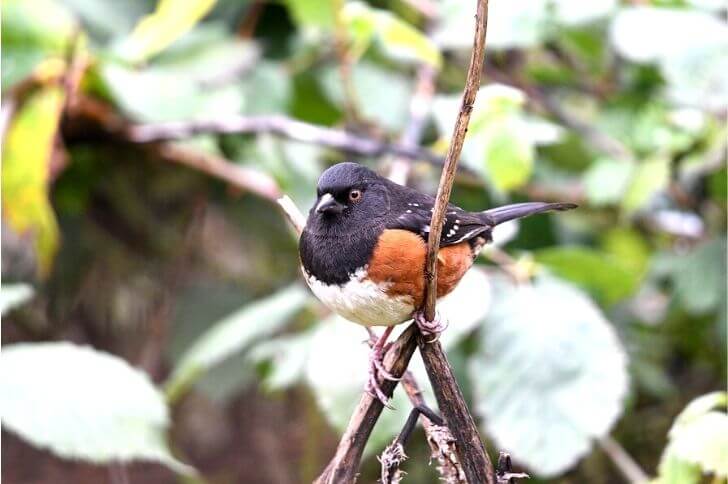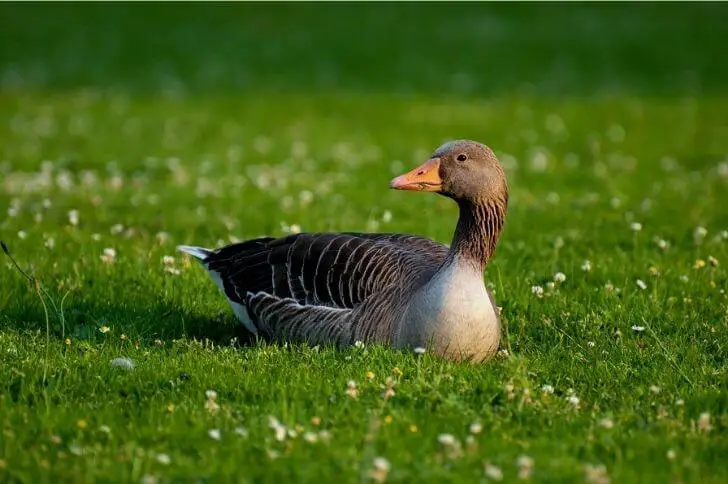It’s not everyday you see black birds with red heads, but when you do, it’s definitely an interesting sight. These birds can be found in North America, the Amazon and other parts of the world. If you are interested in red headed birds with black bodies, this article is for you.
From small shy birds to large aggressive birds, we’ll list them all, their characteristics, vocalizations and more. So get your pen and let us get started.
List of Black Birds with Red Heads
1. Red headed woodpecker

The Redheaded Woodpecker is one of the most easily identified woodpeckers in North America. They are a medium-sized woodpecker, about 9 inches long with a wingspan of up to 16 inches.
Both sexes spot a red head, black back and wings, and white underparts. Notice the pale black-tipped bill.
Where do red-headed woodpeckers live? They favor open woodlands, parks, and gardens. Redheaded Woodpeckers feed on insects, spiders, nuts, and fruit. They peck into tree bark to find insects to eat, and they also store food in crevices in the bark. This behavior is known as food caching.
They build up-shaped nests where the female lays 4-6 eggs and both parents help incubate the eggs and care for the young birds.
How can I get red-headed woodpeckers to my home? You can attract this black bird with red head by placing the right feeders, using foods they eat, and putting a large bird house.
2. Pileated woodpecker
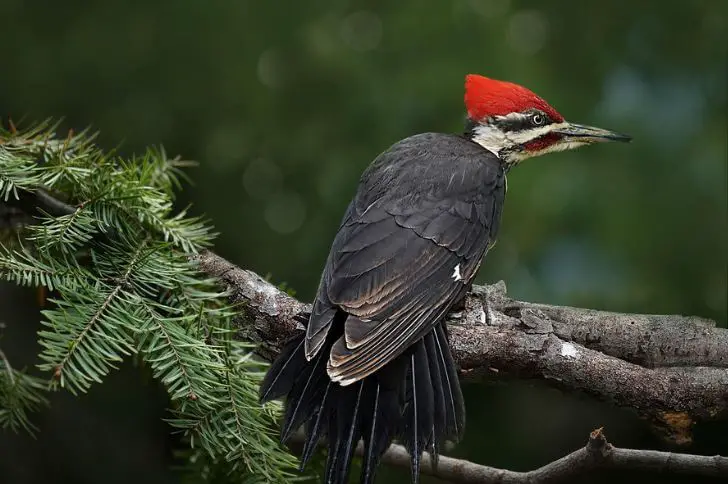
Another type of red headed blackbird is the pileated woodpecker. Measuring up to 19 inches, it is the largest woodpecker in North America. They are easily identified by their characteristic red crest and black and white plumage.
The bill is strong to help it chip through barks. These birds can be found in a variety of habitats, from forests to parks to residential areas. Pileated woodpeckers feed on a variety of items, including nuts, and fruits. Like their relatives above, they also store food for later use.
Pileated woodpeckers are cavity nesters, meaning they build their nests in tree cavities. They are monogamous and typically mate for life. Pileated woodpeckers are known for their loud vocalizations, which can be heard from a great distance.
Where are pileated woodpeckers most common? If you live in the Eastern United States and have a few feeders at the back, you will most likely spot them.
Do pileated woodpeckers eat squirrels? No. For protein they feed on ants they find in crevices.
3. Scarlet-headed blackbird

Source: barren_steppe
Scarlet-headed blackbirds are medium-sized red-headed blackbirds. This large black bird with red head breeds from Argentina to Southern Brazil.
Both sexes are mainly black plumage with a brilliant red head. The juvenile is duller than the adult, but has the characteristic scarlet head. This species inhabits open country near water, such as ponds and lakes.
The scarlet-headed blackbird builds a large cup nest of sticks in a tree or bush close to water. 2-3 eggs are laid and incubated by the female for 11–13 days. The chicks are fed by both parents and leave the nests after about 16 days.
4. Turkey vulture

Turkey vultures also known as the turkey buzzard, is a large bird of prey found in North and South America. It is a member of the family Cathartidae, which also includes the black vulture and greater yellow-headed vulture. This large red-headed black bird is one of the most common vulture in North America.
Unlike other birds on this list that spot red feathers on their heads, the turkey vulture has a bare red skin on its head, giving it a red-colored head appearance. The rest of its body is black. It has a long, hooked beak that it uses to tear meat. The turkey vulture’s wingspan can reach up to 6 feet.
Turkey vultures are scavengers that feed on dead animals. They can often be seen soaring overhead looking for food. They are very efficient at eating decomposing flesh, and can consume up to 2 pounds of meat per day.
How do you scare turkey vultures? Best way to scare them from your backyard feeders is by using non-lethal methods. Spray them with a garden hose or install an ultrasonic repellent.
Can a turkey vulture pick a dog? Yes, this vulture can pick smaller breeds of dog easily.
Related read: Different types of blackbirds
5. Red-headed manakin

Source: dalfenas
What is a red-headed manakin? Also known as the Ceratopipra rubrocapilla, it is a small bird with red head is found in tropical lowland forests of Brazil. How can you identify red-headed manakins? Like other birds in their family they are exhibit sexual dimorphic traits. Males have an all-black body with a red head, note their pinkish feet.
On the other hand females are olive-green with whitish underparts. Both sexes measure about 4 inches long and weigh around 0.3 oz.
These birds are usually seen in small flocks, foraging on the ground for seeds and insects. They can be very tame and will often come to people to beg for food. The red-headed manikin builds a cup-shaped nest from grasses or other materials, which is usually placed low in a tree or bush. 4-6 eggs are laid, which are incubated by the female for 12-13 days.
What do red-headed manikin eat? Mostly seeds and insects. Also this bird is known for “drree-dit” sounds.
6. Red-headed vulture

Not to be mistaken with the turkey vulture above, the red-headed vulture is one of the most unique birds in the world. This black bird with red on head is a resident breeder in India.
It is a large bird, with a wingspan of up to eight feet, and it has a reddish bare head and neck. The rest of its body is a black.
Preferring a solitary life, the Asian king vulture lives in forests and grasslands, and eats small animals such as snakes, lizards, rodents, and birds. Unlike the turkey vulture, it is a shy bird, preferring to stay hidden.
Where do red-headed vultures like? You can spot them in delicious forests where they build their nests on tall trees.
Is the red-headed vulture endangered? Yes, in 2007 they were listed as critically endangered. But, special programs have been put in place to protect and help increase their numbers.
7. Crimson-headed partridge

Source: wildliferuthelens_macro_bird
The crimson-headed partridge or haemothorax sanguiniceps was first described in the 1800s . Mainly found in elevated parts of Southeast Asia, it is a small black red-headed bird that is from the pheasant family (Phasianidae).
This species has a red head, rufous breast, black body, and red undertail coverts. Both sexes have dark eyes with a yellowing eye-ring and brownish legs.
The diet of the crimson-headed partridge consists mainly of insects, but they will also eat seeds and fruit. This species is usually seen singly or in pairs, but sometimes forms small flocks.
They are known for their clucking “kak-kak” and metallic “ring-ying” This black bird with red head lays up to 8 brownish eggs that take about 19 days to hatch.
8. Red-headed myzomela
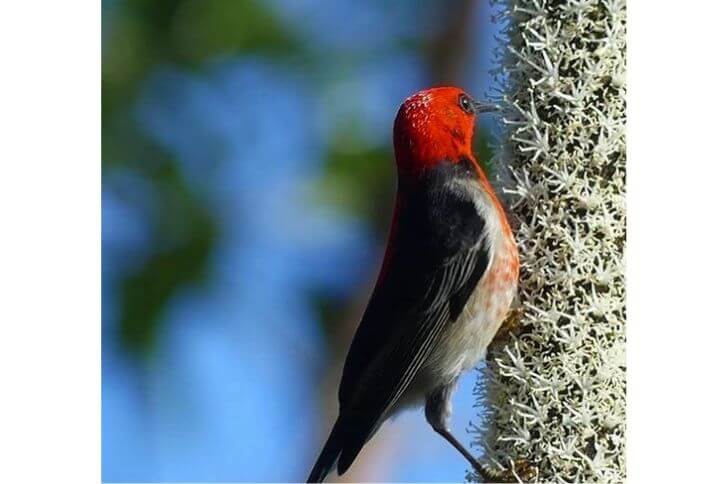
Source: omazingwellness
Red-headed myzomela is a small passerine bird found in Northern Australia. It has a bright red head, black wings and back, and a grayish underside. The species is sexually dimorphic, with the female spotting a grey-brown body and reddish face.
Red-headed myzomela are generally shy birds, but can be very vocal, making high-pitched calls in flight or while perched. Their calls include soft “swip-swip” notes and harsh “charrrk-charrk” sounds.
What does the red-headed myzomela eat? Note the long curved black beak? They use it to feed on nectar, and fruit. Their breeding season starts from June – October. They use plant fiber and leaves to build nests that can hold 2 – 3 eggs. Chicks leave their homes at around four weeks after hatching.
Red-headed myzomela are common and are enjoyable to watch. So if you are planning to go bird watching in Australia, add this red-headed bird on your must-see list.
9. Crimson-crowned flowerpecker

The crimson-crowned flowerpecker is a small, passerine bird found in the forests of Southeast Asia. They are typically around 3.5 inches in length and have a bright red cap and a red spot on their chest with black wings and tail. Their belly is whitish.
They are insectivorous and feed on a variety including beetles, ants, and caterpillars. Crimson-crowned flowerpeckers are monogamous and pairs stay together for life. They build their nests out of twigs high in trees and lay 2-4 eggs per clutch. They are known for their loud “tzeet” notes.
10. Red-headed malimbe
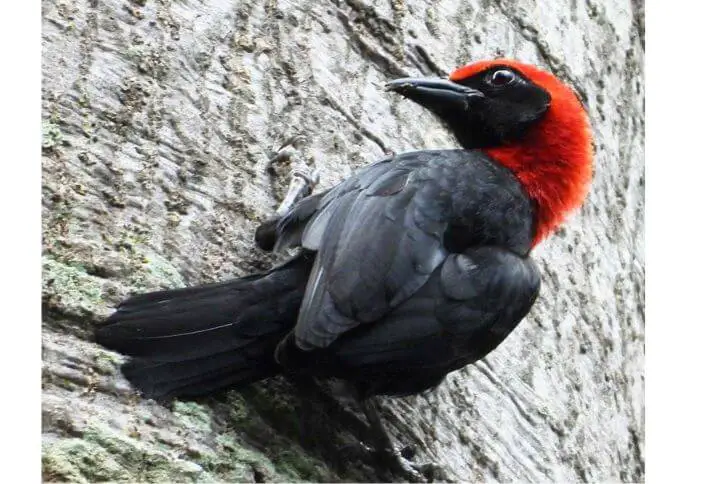
Source: craigm2931
A new bird species has been discovered in the rainforest of Africa and it has a bright red head. The bird is a malimbe and has been given the scientific name of Malimbus rubricollis. It is the a member of the Malimbus genus that includes other black birds with red heads.
Are you interested in Pets?
The malimbe is a small bird that measures about 9 inches in length. It has a red head and black body. It is a shy bird that prefers to stay hidden in the dense undergrowth of the rainforest.
Little is known about the ecology of the malimbe. It is believed to be a seed-eater and may also eat insects. The malimbe has been seen feeding at fruit trees and flowering bushes near streams and rivers.
11. Scarlet-horned manakin

Source: levisluloulolu
Scarlet-horned manakins (Pipra cornuta) are small passerine birds found in the Neotropical ecozone. The male of this species is striking in appearance, with its black plumage, scarlet head and horn-like tufts on the sides of its head.
Females feature a pale underside and olive-green upperparts. It is a vocal bird, and its song is a series of high-pitched trills. Scarlet-horned manakins are found in forests and woodlands, where they typically perch high in the trees.
They are monogamous, and the male establishes and defends a territory. The female builds a small cup-shaped nest from plant material, which she incubates for around two weeks. After hatching, the chicks are fed by both parents for about six weeks before becoming independent.
12. Scarlet-banded barbet

Scarlet-banded barbets or the Capito wallacei is a species of bird in the family capitonidae. Its Favorite habitats are in tropical moist lowland forests or subtropical or tropical montane forests.
The bird measures about 7 inches long and weighs up to 2.8 oz. Its back is black, with a red head and yellow belly. This small black bird with red head breeds from March through May. They are known for their unique song; a soft “tdddd” sound.
13. Crimson-crested woodpecker
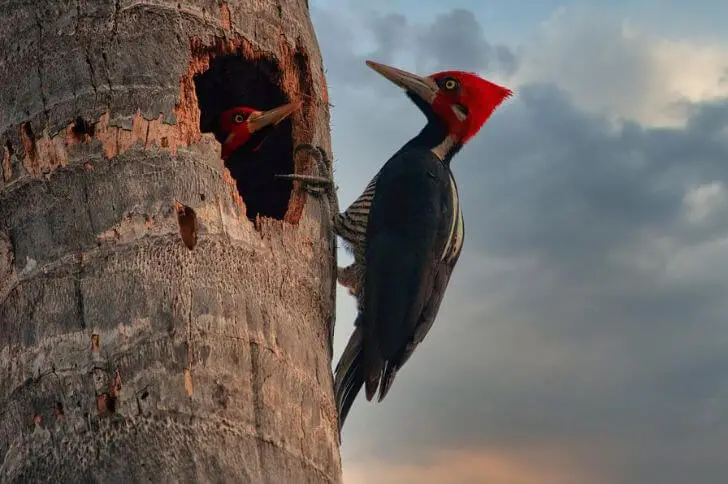
The crimson-crested woodpecker is a striking bird that can be found in South America. The adult has a red head, black back and a heavily barred underside. They measure about 15 inches long and weigh about 10 ounces.
These woodpeckers live in forests and woodlands, where they eat insects. They build their nests in tree cavities or sometimes use an old nest of another bird. These birds are monogamous and both the male and female take turns incubating the eggs. The chicks are born naked and helpless and stay in the nest for about 5 weeks.
14. Crimson-hooded manakin

Source: bucktuh
The crimson-hooded manakin, or simply the crimson manakin (Manacus vitellinus), is a small passerine bird of the manakin family. It is found in Brazil and Venezuela. The male is striking in appearance, with a bright red head with hints of yellow and black upperparts. The female is olive-green. Juveniles are similar to the female but have duller plumage.
This species is found in open woodland and forest edges. The male sings from an exposed perch to defend its territory. The female builds a small cup-shaped nest from plant fibers, which she incubates for around two weeks. The chicks are fed by both parents and fledge after about two weeks more.
The crimson-hooded manakin is a common bird and not considered threatened by the IUCN.
15. Acorn woodpecker
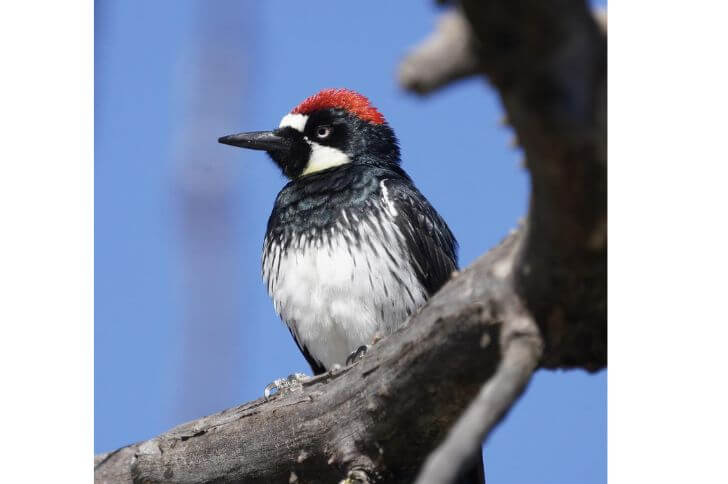
Acorn woodpeckers are a small North American bird that is easily recognized by its black, white plumage, red cap and the acorns that it stores in tree crevices or carries in its bill. These birds are common in open woodlands, parks, and gardens.
They usually forage on the ground, but they can also be found up in trees where they search for insects. Acorn woodpeckers breed from late winter into spring, and the females lay between three and six eggs in a hole that the male has drilled in a tree. Incubation lasts about two weeks, and both parents help to feed the young.
16. Black-bellied myzomela

Source: birdingecotours.com
Striking and gorgeous, the black-bellied myzomela or Myzomela erythromelas is a small passerine bird found in New Guinea and some nearby islands. It belongs to the honeyeater family.
It is sexually dimorphic, with the male being black on the belly, throat and upperparts and a stunning red head, while the female has a buffy underside and olive-green upperparts. Both sexes have a long, curved bill. The black-bellied myzomela is usually seen in pairs or small groups.
It feeds mainly on nectar from flowers, but also takes insects. The black-bellied myzomela is not considered endangered.
17. Black-bellied seedcracker

Source: ebirdography
The black-bellied seedcracker is a small passerine bird found in tropical forests of Africa. It is a member of the family Estrildidae, and is placed in the genus Pyrenestes. This species was first described by the English ornithologist Philip Sclater in 1855.
The black-bellied seedcracker is typically 5 inches long and weighs 0.5 oz. It is mainly black with a red head and tail. Juveniles and females are a dull brown. The bill is black colored, and the legs are brownish.
The black-bellied seedcracker inhabits woodlands, plantations and gardens near water sources.
18. Wire-tailed manakin

Source: manuelaseifert1
Wire-tailed manakins are Central America birds that are sexually dimorphic. Males are black with red heads while the females are mostly olive-green. The males have long, thin tails which they use in displays to attract mates.
These birds are very territorial and aggressive towards other males, and can often be seen chasing each other around in courtship rituals. Wire-tailed manakins typically live in pairs or small groups and feed on fruit, insects, and nectar.
19. Rote myzomela

Source: arthurgeilvoet
Another black bird with red on head is the Rote Myzomela which is endemic to the islands of Rote and Kisar in the Lesser Sundas, Indonesia. The Rote Myzomela is a small passerine bird about 4 inches long. The male is brightly colored with a red head and black body. The female is duller with mostly brown plumage. Both sexes have a long tail.
The diet of the Rote Myzomela consists mainly of insects, but they will also take nectar from flowers. They are usually seen in pairs or small groups, foraging through the undergrowth for insects or perched on a branch singing their loud song.
Final thoughts on red-headed black birds
1. What bird is black with red head? They include
- Red-headed woodpecker
- Black-bellied seedeater
- Acorn woodpecker
- Red-headed vulture
- Turkey vulture
2. Can wren have red heads?
Yes, the house finch has a red head and a brownish body.
Hi, my name is Steve. My friend and I started the spanishbirdguides.com to share our passion with other like-minded people. So, if bird watching is your thing, you’ll love this blog. I’ll share what I’ve learnt about both local birds and those found in other parts of the world. Also, I’d love to hear your experiences.
